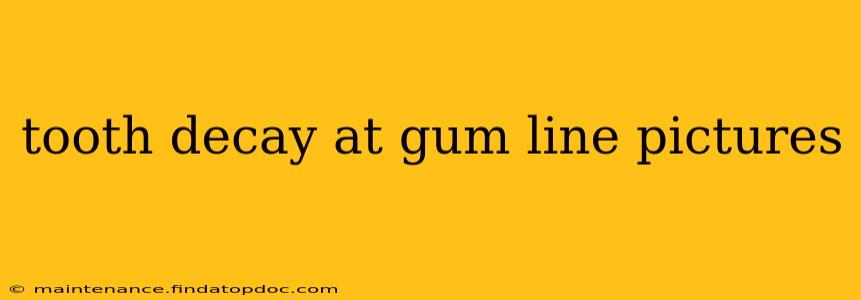Tooth decay, also known as dental caries or cavities, can occur anywhere on your teeth, including the gum line. This location makes it particularly challenging to detect and treat, often leading to more significant problems if left untreated. This article will explore the appearance of gum line decay, its causes, and the necessary treatment options. We'll also address some common questions surrounding this dental issue.
What Does Tooth Decay at the Gum Line Look Like?
Unfortunately, visual identification of gum line decay can be difficult for the untrained eye. The area is often hidden beneath the gum tissue, making early detection challenging. However, some telltale signs to watch for include:
- Discoloration: The affected area might appear darker than the surrounding tooth enamel, ranging from brown to black.
- Sensitivity: Increased sensitivity to hot, cold, or sweet foods and drinks is a common symptom, even before visible decay appears.
- Receding Gums: If you notice your gums receding, it could expose decayed areas previously hidden beneath the gum line.
- Bad Breath (Halitosis): Persistent bad breath, even after brushing and flossing, can signal the presence of decay.
- Pain: As the decay progresses, you might experience pain, especially when chewing or biting.
While images can be helpful, it's crucial to understand that every case is unique. Seeing a dentist for a professional examination is the only reliable way to diagnose gum line decay.
What Causes Tooth Decay at the Gum Line?
Several factors contribute to the development of tooth decay at the gum line:
- Poor Oral Hygiene: Inadequate brushing and flossing allow plaque and bacteria to accumulate along the gum line, leading to decay.
- Diet: A diet high in sugary and acidic foods and drinks creates an environment where bacteria thrive, producing acids that erode tooth enamel.
- Medications: Some medications can cause dry mouth, reducing saliva production, which is crucial for neutralizing acids and protecting teeth.
- Gum Disease (Periodontal Disease): Gum disease can cause gum recession, exposing the root surfaces of teeth to decay.
- Genetics: Some individuals are genetically predisposed to developing tooth decay more easily than others.
How Is Tooth Decay at the Gum Line Treated?
Treatment for gum line decay depends on the severity of the decay. Options may include:
- Fluoride Treatments: For early-stage decay, your dentist might recommend fluoride treatments to strengthen the enamel and prevent further damage.
- Fillings: If the decay is more extensive, your dentist might need to remove the decayed portion of the tooth and fill the cavity with a filling material.
- Crowns: For more severe decay, a crown might be necessary to protect the remaining tooth structure.
- Root Canal: In cases where the decay has reached the pulp (the soft tissue inside the tooth), a root canal might be required to remove the infected pulp and save the tooth.
- Extraction: In severe cases, if the tooth is beyond repair, extraction might be the only option.
Can Tooth Decay at the Gum Line Be Prevented?
Absolutely! Prevention is key, and adopting these habits can significantly reduce your risk:
- Practice Excellent Oral Hygiene: Brush your teeth twice daily with fluoride toothpaste and floss daily. Use a soft-bristled toothbrush and proper brushing techniques.
- Maintain a Healthy Diet: Limit sugary and acidic foods and drinks. Consume a balanced diet rich in nutrients.
- Regular Dental Checkups: Visit your dentist for regular checkups and professional cleanings. Early detection is crucial for effective treatment.
- Use Mouthwash: Consider using a fluoride mouthwash to further protect your teeth.
What are the signs of gum disease?
Gum disease, or periodontal disease, is characterized by inflammation and infection of the gums. Signs include:
- Red, swollen, or tender gums.
- Bleeding gums during brushing or flossing.
- Receding gums.
- Persistent bad breath.
- Loose teeth.
- Pus between the teeth and gums.
How can I tell the difference between gum disease and tooth decay?
While both gum disease and tooth decay can affect the gum line and cause similar symptoms like bleeding gums and bad breath, they are distinct conditions. Gum disease affects the gums and supporting structures of the teeth, whereas tooth decay specifically affects the tooth structure itself. A dentist can accurately diagnose the condition through a thorough examination.
Does tooth decay always cause pain?
No, tooth decay often doesn't cause pain in its early stages. This is why regular dental checkups are crucial for early detection. Pain usually develops as the decay progresses and reaches the inner layers of the tooth, affecting the pulp.
Remember, this information is for general knowledge and doesn't replace professional dental advice. If you suspect you have tooth decay at the gum line, schedule an appointment with your dentist for proper diagnosis and treatment.
